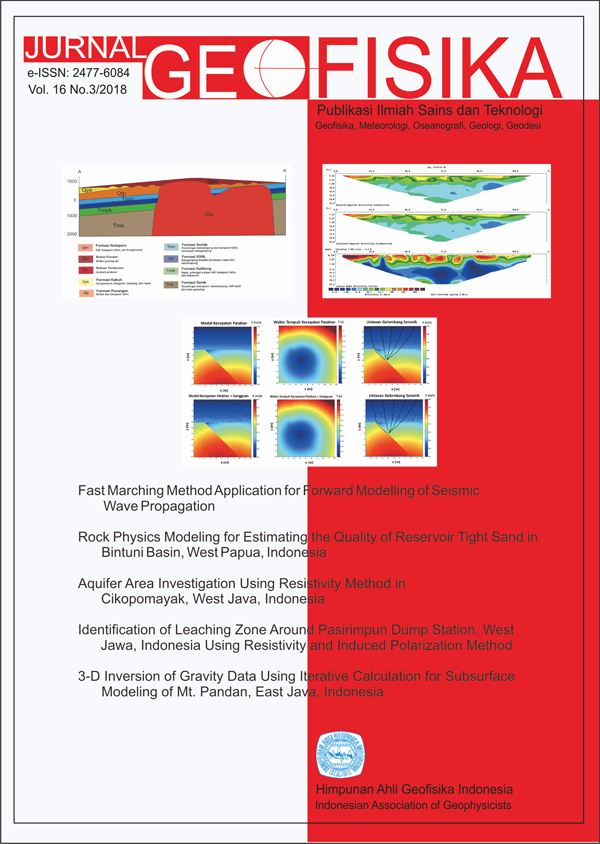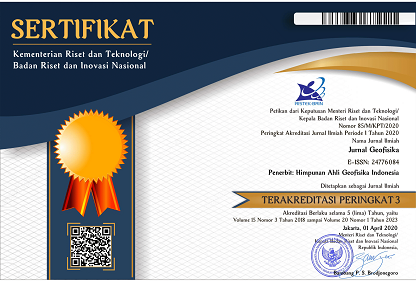Rock Physics Modelling for Estimating the Quality of Reservoir Tight Sand in Bintuni Basin, West Papua, Indonesia
Abstract
Permeability is a key to determine the quality of reservoir. Reservoir quality can be dened as the ratio between permeability and porosity of a rock. Besides, permeability is not in uenced by porosity solely, there are other
factors which aect the value of the permeability of a rock. One of them is aected by the pore structure, which includes turtuosity, surface area, and grain size. To determine how much these factors aect the permeability of a rock, it takes an elastic parameters that can be an indicator of the quality reservoir e.g pore space stiness and critical porosity.Primary data such as petrophysics, XRD data, and permeability are used as input data to determine the quality of reservoir. By using Zimmerman's equation and Nur's model, we will get the value of pore space stiness and critical porosity at each point. The combination of rock quality equation derived from Kozeny Carman's with elastic parameters as indicators produces qualitative rock quality identification. Results of this study is able to show that the pore space stiffness and critical porosity can represent turtuosity, surface area, and grain size of a rock which lead to the determination of rock quality. The method proposed in the present study demonstrated an excellence reservoir quality prediction based on the relation between petrophysical parameters with elastic parameters.
References
Chapuis, Robert P., dan Aubertin, Michel. (2003). Predicting the Coefficient of Permeability of Soils using the
Kozeny-Carman Equation. Montreal: Department CGM, Ecole Polytechnique de Montreal.
Chandra, Tanmay. (2008). Permeability Estimation using Flow Zone Indicator from Well-log Data. Dhanbad: Dept. Of Applied Geophysics, ISM University.
Kumar, D. (2006). A Tutorial on Gassmann Fluid Substitution: Formulation, Algorithm and Matlab Code. Geohorizons, January 2006, page 5-12
Lee, Myung W. (2005). Proposed Moduli of Dry Rock and Their Application to Predicting Elatic Velocities of Sand-
stones. Virginia: U.S Geological Survey Scientific Investigastion Report 2005-5119, 14 p
Mavko, G., Mukerji, T., dan Dvorkin, J. (2009). The Rock Physics Handbook. New York: Cambridge University
Press.
Nur, A., Mavko, G., Dvorkin, J., dan Gal, D., (1995). Critical Porosity: The Key to relating Physical Properties to
Porosity in Rocks. In Proc. 65th Ann. Int. Meeting, Soc. Expl. Geophys., vol 878. Tulsa, OK: Society of Exploration
Geophysicists.
Panuju, F, Mufdi., P, Imam., R, Ginanjar., F, Iskandar., dan Buskamal. (2012). Zona Biostratigrafi Nanoplankton
Berumur Coniacian-Maastrichtian (Kapur Akhir) Cekungan Bintuni, Kepala Burung, Papua. Jakarta: Exploration
Division, PPPTMBG, LEMIGAS.
Permadi, Pudji., and Kurnia, Ivan. (2011). Rock Type Based Permeability Prediction Using Routine and Special Core Analysis Data. Bandung: Institut Teknologi Bandung.
Pride, S. R. (2005). Relationships Between Seismic and Hydrological Properties, In Rubin, Y., and Hubbard, S. eds. Hydrogeophysics: New York, Kluwer Academy, p. 217-255
Russel, B. (2013). A Gassman Constituent Rock Physics Template. CSEG Recorder.

This work is licensed under a Creative Commons Attribution 4.0 International License.
The copyright of all articles belongs to the authors. All other copyrights is held by the Journal











